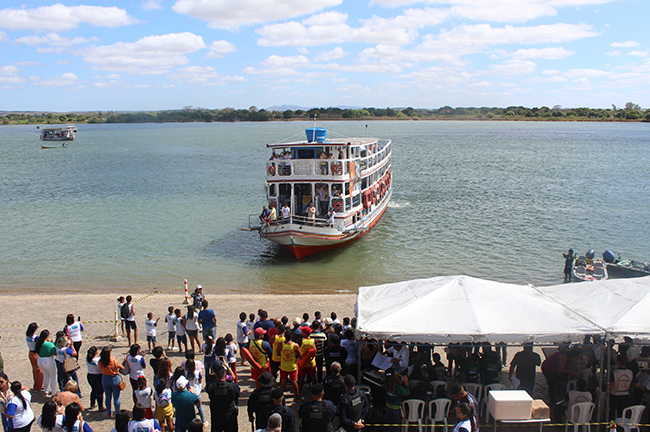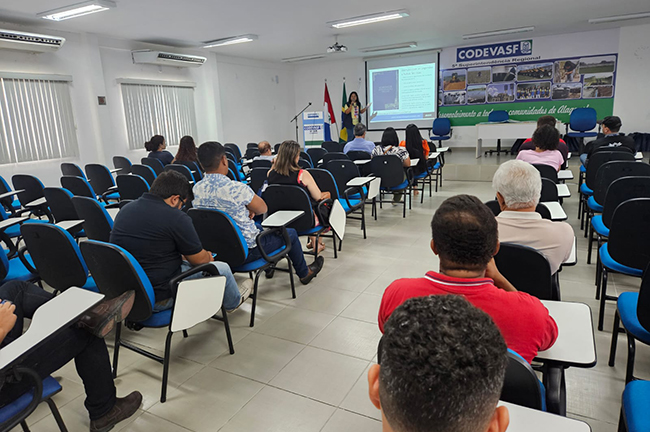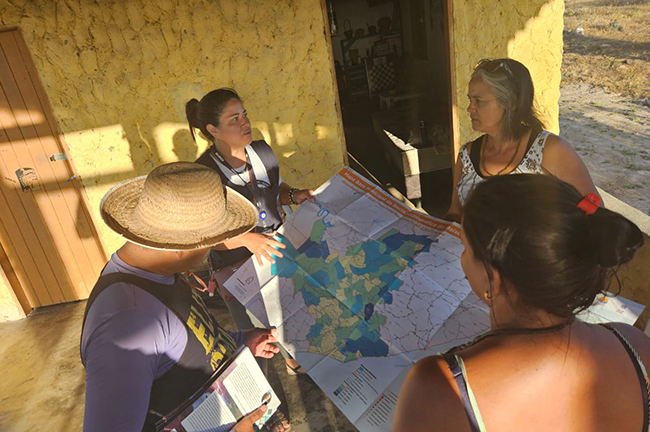Expedition
Mission accomplished: IBGE’s participation in the VI Low São Francisco Scientific Expedition brings the Institute closer to riverside populations
December 08, 2023 03h00 PM | Last Updated: December 20, 2023 10h13 PM

It was 6:30 in the morning and the sun was shining in the sky. Vessels Magnífica (Magnificent) and Maravilhosa (Wonderful) honked their horns to show that departure time was close: that was the first trip of the VI Low São Francisco River Scientific Expedition. At that moment, we were leaving Piranhas and heading for the municipality of Pão de Açúcar.
That scene was replayed every morning. The boats departed very early towards a neighboring port taking professors, researchers and, of course, the IBGE team.
The sixth edition of the Low São Francisco Scientific Expedition, organized by the Federal University of Alagoas (UFAL), and which took place from November 21 to 30, was the first one attended by the IBGE. The Institute monitors the activities of Riverside municipalities in the states of Alagoas and Sergipe.
After the opening in Piranhas, the Expedition passed through the cities of Pão de Açúcar, Traipu, São Brás, Propriá (the only municipality in Sergipe), Igreja Nova, Penedo and Piaçabuçu, where the São Francisco river mouth is located.
The arrival of the Expedition in cities was a major event: local bands, talks by students, speeches by authorities and fireworks were some of the attractions presented each time.
And the work began soon afterwards.
IBGE representatives and donations of books to municipalities
About 100 persons joined the expedition, including those on board and the support team on land, representing a total of 35 institutions. Civil servants Silvânia Vila Nova and Vinícius Andrade, from the IBGE Superintendencies in Alagoas and Sergipe, respectively, were the representatives of the Institute in this adventure, and spent all the period of the Expedition onboard. But They did not feel disheartened by the challenge, quite the opposite: “Sleeping in a hammock did my spine a lot of good,” joked Ms. Vila Nova.
And every day, the word “tiredness” was not part of the vocabulary of used by these servants or by Magali Andrade and Hellie Mansur, responsible for monitoring on land, and providing support to presentations by the Institute.
To each municipality participating in the Expedition, the IBGE donated two kits of books to be used in school libraries of Municipal Education Secretariats. A total of 720 institutional books, including School Atlases, Brazil in Figures and Through the Enumerator’s Lenses.
Besides these, managers, students, researchers and the population in general received volumes of the book “Municipal Socioeconomic Profile and geo-environmental Aspects of the Low São Francisco”, organized by Neison Cabral, researcher and supervisor of the Section for information Dissemination (SDI) of the IBGE in Alagoas, and Rose Mary Gomes, communication assistant of UFAL.
Attached to the book is a map of the water basin of the region, which portrays all the 93 municipalities and was launched in the opening of the Expedition, in Piranhas.
“This material is a very important resource that can be used by the teach to make classes more dynamic and promote more interaction between students, causing them to get better knowledge about the reality and the geography of the place where they live,” reported Pedro Henrique Lira, Science Technician for the Education Secretariat of the municipality of Traipu.
The participation of the IBGE in the VI Low São Francisco Scientific Expedition was also celebrated by researchers taking part in it.
A total of 3,000 map booklets of IBGE Teaches were distributed among children. The material was produced especially for the occasion, and presents information and photos of the region. “The IBGE Teaches presentations have been a great incentive of the Expedition, because children are very curious and want to know more about the place Where they live,” said professor José Vieira, from UFAL, who also calls attention to the acceptance and good reputation of the Institute.
Besides participating in the Expedition, the importance of data from IBGE surveys was also mentioned by the researchers. Tatiane Balliano, a professor at the UFAL’s Institute of Chemistry and biotechnology, said Census data are of fundamental importance for her research on the characterization of microplastic: “The correlation of Census data with these collected by us is extremely important, because we need to understand the coherence of the quantity of pollutants in relation to the size of the population in the cities”.








IBGE Teaches Offline presentations
After an entire day of hard work in Pão de Açúcar, the IBGE servant Otávio Valentim was already sitting in the official car, ready to depart to the city of Traipu, where the Expedition activities would be held the following day. It was then that three children approached him asking to record a video.
The three students had just concluded their participation in the IBGE Teaches Offline there and wanted to speak, proudly, about what they had learned. “In this event I had the chance of learning about the IBGE, about its work. They visit your home and count how many people live there,” said one of the students.
The IBGE Superintendence in Alagoas (SES/AL) adapted the IBGE Teaches platform, which is available online, to be used without the need of Internet in schools. The activities are conducted using a projector, a canvas screen and a laptop. Every day, IBGE servants face temperatures that near 40ºC in gymnasiums and schools to make presentations about the IBGE Teaches Offline platform.
In these activities, Silvânia and Vinícius showed the students some functionalities of the platform, by means of information about the Census and other IBGE surveys with municipal data, such as the Municipal Agricultural Production (PAM) and the Municipal Livestock Survey.
The inclusion of local information in these presentations such as fish farming and livestock production, besides data on the population, specific for each city, helps children in the territorialization of their own knowledge. And they would often say, very excitedly, during the presentations: “my father is a fisherman”, “my aunt grows corn,” “my uncle has a farm with twenty cows,” “I’ve already seen sheep!”
Nevertheless, games such as the Map Puzzle, were the main attraction for kids. In this game, which led to moments of fun and interaction, they had to fit together parts of the map of Brazil, by identifying each Federation Unit. It was also an opportunity for children to stand up and participate more actively in the presentation, leaving behind the traditional sit and watch model.
One of the meetings in the Expedition turned into a valuable partnership. The IBGE received support from Willian Soares, nicknamed Will, a teacher and storyteller who was also attending the event organized by UFAL. With his distinctive hat that resembles a vessel, and his talent to enchant children with his narratives, Will entertained students by telling them stories about the São Francisco river right before each IBGT Teaches presentation.
“Being part of the IBGE team was a fantastic experience, an innovative one for the institution itself. With this Project IBGE Teaches Offline, I believe we are making access to data from the different surveys more democratic,” said Silvânia about their participation in the Expedition.
Round of lectures about data from the IBGE
There were a lot of activities performed by the Institute during the VI Expedition. In Penedo, a lecture was given to managers and the academic community about the main tools used to access data produced by the IBGE, with a workshop in map construction taught by servants Neison Freire and Silvânia Vila Nova, at the auditorium of the Development Agency of the São Francisco River Valley (CODEVASF).
Students of Tourism, Fishing Engineering, Production Engineering and information Technology at UFAL, had the chance of attending a lecture delivered by servants Alcides Tenório Jr. (IBGE Superintendent in Alagoas), Alcides Bruno de Oliveira (head of the Penedo Branch) and Neison Freire (Head of the Information Dissemination Supervision Department). There, servants presented age and population data from the 2022 Census, control and data collection processes of the census operation, and also provided an overview of products launched by the Institute during the Expedition. Also, they dealt with possible connections between data from the IBGE and the university.
“The lecture was extremely important to our students, and they could understand the challenges faced by the IBGE to collect these data and conduct the census operation, and to produce this x-ray of reality, of the state, of the population,” stated Alfredo Mojica, a professor of the Fishing Engineering Major at UFAL.
Mojica, who is also a member of the Expedition, also highlighted the role of IBGE data in the elaboration of public policies and academic surveys. “Our task now is to promote fish farming in the state. These are important data to guide us so that we can develop the productive chain and help the Low São Francisco area,” he stated.
IBGE makes a presentation to foreign schools during the Scientific Expedition
One of the most curious moments during the Expedition was the presentation of IBGE data to foreign children, done through an online platform in collaboration with other researchers, directly from the Vessel Magnífica. The initiative was established in partnership with the Exploring By the Seat of Your Pants, an organization that hosts live expeditions and scientific events around the world to children in schools in Canada, United States, United Kingdom, and Australia. On behalf of the IBGE, civil servant Neison Freire, shared information about the characteristics of the Low São Francisco and data from the institute's surveys. The interaction included questions from children and teachers from seven American and Canadian schools, and after being recorded, the lesson was redistributed to 100,000 classrooms across the countries covered by the organization.
IBGE in the field: an expedition, many routes, peoples, landscapes and memories
“São Francisco River / A millionaire dressed in tatters / Rags and tatters of immense sails dragging ferries / Sleepy, very slowly / Upstream, downstream”, sings the poet Jesuíno Antônio Dávila, from the state of Pernambuco.
The expedition covered 240 km over ten days. From Brazil's northeast, where the river meets the caatinga vegetation and the Xingó hydroelectric power plant in Piranhas; to the river mouth, where the waters of the São Francisco finally meet the sea.
The IBGE’s participation in the VI Low São Francisco Scientific Expedition in the states of Alagoas and Sergipe was marked by multiplicity: various activities carried out, people attended, landscapes seen, cultural expressions and knowledge exchanged, showing a portrait as diverse as the country itself.
The start, in Piranhas, brought the first contact with the caatinga vegetation, the only exclusively Brazilian biome, a symbol of the northeastern hinterland, which is also irrigated by the fury of the waters of the Velho Chico (Old Chico, a nickname for the São Francisco River). In Pão de Açúcar, the traditional annual performance, the Chegança, representing maritime exploits, welcomed the expedition members. In the city of São Brás, the indigenous people of the Aconã village were introduced to IBGE data in their own territory. The same happened in Porto Real do Colégio, in the meeting with the Kariri-Xocó indigenous people.
It was in the Chinaré village, in Igreja Nova (AL), however, that one of the most important events happened. The population accompanied the Magnífica and the Maravilhosa on own their boats as they came ashore. On the other hand, in the city, there was a presentation of the Guerreiro, a folk dance that is part of this intangible cultural heritage of Alagoas. And once again, of course, the Institute was present in schools, with the IBGE Teaches Off-Line.
The meeting with traditional communities also included the quilombolas. IBGE civil servant Silvânia Vila Nova (SDI/AL) visited the Pixaim village in the city of Piaçabuçu, near the mouth of the São Francisco River. There, quilombo remnant communities lead isolated and semi-nomadic ways of life, moving from time to time between the sand dunes that continuously affect the landscape. These are the so-called "living hills" of Pixaim village. There, the quilombolas are received the IBGE - previously during Census operations and now during the Expedition, sharing and discussing the results. The communities of Tabuleiro dos Negros (Penedo) and Sapé (Igreja Nova), both in Alagoas, were also visited during the Expedition.
"The participation of the IBGE in this type of event, for me, is very significant. (...) Sometimes, the university organizes events like this, an expedition like that, which collects data, but it remains confined to the academic field. And when you bring the IBGE into this, you are bringing Brazil. You are bringing the tentacles of the main provider of data and information about Brazil to the people," says Professor Raul Rodrigues from Radio Penedo FM, where institute representatives joined a live conversation for over 2 hours.
Bringing Brazil, and especially bringing the Low São Francisco River closer to the IBGE was one of the main objectives of the Institute's participation in the VI Scientific Expedition, in collaboration with the UFAL. This partnership, in addition to fostering knowledge sharing activities and contributing to the distribution of educational materials, also aimed to enhance the institutional image, demonstrating that IBGE is an ever-present institute when it comes to the field, and that goes far beyond the Census and it is crucial for the formulation of public policies and citizen formation.
Throughout their 240 km journey over eight cities, the civil servants from SES/AL, SES/SE, and SES/BA joined efforts to accomplish the institutional mission guiding IBGE professionals: " Portraying Brazil with the necessary information to the knowledge of its reality and the exercise of citizenship " - now, in loco (in the proper place), getting closer to the riverside population.
The seed planted by the IBGE expedition team continues to bear fruit in Brazil even after the conclusion of the Expedition: in Tabuleiro dos Negros, a quilombola community in Penedo (AL), children from the community now have access to the IBGE Teaches folder-map and are studying it in the classroom.
“"Come closer, dear managers, to your territories. We are a mirror for the upcoming generation. We are an inspiration for children who often lack role models. The Velho Chico [São Francisco River] tell us what to do. Those who get connected with the waters of the São Francisco River know the answers," said Professor Vieira, one of the coordinators of the Expedition, during the closing ceremony.


















